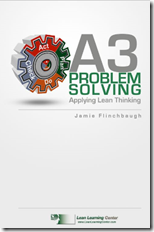Решил выкладывать тезисы некоторых интересных книг. Во-первых, так можно будет легко освежить книгу в памяти. Во-вторых, возможно, это будет полезно кому-либо ещё, особенно с учётом, что часть книг куплена на Amazon и в свободном (пиратском) доступе напрочь отсутствует.
 |
Название: A3 Problem Solving: Applying Lean Thinking Автор: Jamie Flinchbaugh Дата издания: 16.02.2012 |
The Lean methodology:
- The lean methodology is the practice of focusing on the processes that create the value while eliminating those that create waste
- Lean businesses constantly focus on generating new knowledge about how their processes and organizations really work.
- You must ask lots of questions. You must question your assumptions, your processes, your policies and yourselves if you are going to improve.
About A3:
- The most common mistake is treating the A3 as a form, instead of a process.
- Fundamentally, faulty problem solving does not arise because the tools are bad; it is because the behaviors and thought processes being used are bad.
- To understand a solution, first, people need to understand how you got there.
- It is important to get the thinking visible to see what is going on. It should flow and be simple to interpret.
- A3 is not the solution; it is just a depiction of the problem-solving process.
- Knowledge sharing and transparency are essential elements of A3 problem solving
Right flow:
- Thinking drives behaviors. Behaviors drive action. Action drives results. No tool can fix poor thinking. To support A3 thinking, your principles and behaviors must be consistent with each other.
- There is no single “right” format, but in general an A3 report flows from a problem statement or gap description, to current reality analysis, description of the target condition, and finally the plan and measurements to evaluate progress and validity. The format itself isn’t important
- Most change programs start from actions and the results begin and end there. But if you want sustainable results, the only way is to get principles and behaviors right. Sustainable lean change has to work at the principles and behaviors level.
- A wrongheaded approach often taken is to start at point B, in other words, to develop a solution and then go looking for a problem to apply it to.
The four quadrants of A3 problem solving
…provide a standardized problem solving process to promote common thinking.
- Problem Statement
- Current Reality
- Target Condition
- Action
Problem statement:
- It is essential to begin with the problem statement, because it is a critical element on the path to lean thinking. The problem statement has a huge impact on the trajectory we take. To develop A3 thinking, you need to correctly identify the problem.
- No matter how well we do at solving a problem, if we solve the wrong problem it was a waste of effort. If you get point A wrong, the problem, then all assumptions made to get to the solution may also be incorrect and, so too, the solution.
- How you structure the problem statement determines your focus.
- Make sure your problem statement is actually about the current observable condition, not about a perceived solution, cause or what you want.
- How you word your problem statement has a huge impact on what data you collect and your observations.
- Pitfalls:
- We underestimate how powerful the problem statement can be.
- Getting locked into the problem statement as though it is written on a stone tablet. You must be willing to adjust your problem statements. This doesn’t mean your original problem statement was wrong. Writing a problem statement is an iterative process — problem statements are changed because you learn stuff through the process of examining the problem.
- Jumping the gun on too many assumptions before the problem statement is created. You insert unexamined causes and solutions into the problem statement, closing yourself off to many possibilities. The earlier example of “we don’t have enough ovens” is an example of putting the solution in the problem statement. There is only one solution to that problem—buy more ovens. It immediately closes you off to many possibilities. When you assume too much too early, you limit what you can learn through observation and examination.
- Recommendations for improving problem statement development:
- Write down the problem statement.
- Rewrite your problem statement as you learn things.
- This is often a much better collaborative process than a solo one.
Current Reality:
- Before you jump to reactive solutions, it is essential to deeply understand the current reality. This is not a sit-down exercise, it is an activity. Go observe what is actually happening. You want the as-is, not the supposed-to-be or the my-belief-is version of reality.
- It is important to directly observe the problem before you can fix it. It is necessary to not just see but actually study and understand the problem. There is a big difference.
- If you start making improvements without understanding the current reality, two things are bound to happen. First, you will repeat mistakes that you have already committed. This makes learning dreadfully expensive. Second, you will discard the good things you are already doing. If you don’t understand what’s working, and more importantly, why it’s working, you are likely to slide backwards as you try to make improvements.
- Only by a deep understanding of current reality can you ensure that success builds on success, and failure is never repeated
- The ability to capture the current condition is found in these two key questions. What do I need to learn more about? And, how can I learn it?
Developing a Target Condition:
- Once a team has developed a clear problem statement and understanding of the current condition, they also must develop a tangible vision of the target.
- A target condition is what you want to achieve. It is a tangible image; something that you can describe. This is not just the result that you want, but how you want things to be or work.
- The target condition should describe what you would see, feel or experience. The target condition is what “good” looks like.
- Our first flawed assumption is that the target condition is simply the absence of the problem, or the inverse of the current condition. This is not a useful assumption.
- We assume developing a target condition is the same thing as developing the action plan. Aren’t the actions the improvements? No, they are not. The actions are what it takes to put the improvements into place.
Turning Thinking Into Action:
- Actions should focus on removing barriers to the target condition.
- The target should be the result of your actions, not the actions themselves.
- When writing the action plan, just answer this question: Who is going to do what by when? Who, what and when are the three essential elements of an action plan.
- Managing actions through the Plan-Do-Check-Act (PDCA) cycle is essential
- Start with a clear Plan. Then Do that Plan. Check means pausing to analyze the results. The Check step sets up the final step, Act or Adjust. You react to what you just learned during Check and either standardize what worked or return to the Plan and try again. Check is where ALL real learning occurs. Without this step, all of your ideas, solutions and plans will remain theories until they are tested in reality.
- Problems should be identified and engaged in at the point of activity, and that, in general, all employees are engaged in problem solving and improvement.
Если вас интересует получение или продление ВНЖ в Словакии — читайте подробнее об условиях и ценах на сайте parus.sk нашей семейной компании Parus Solutions, которая успешно занимается этим с 2015 года.
